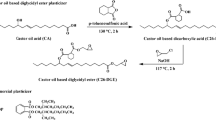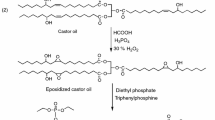Abstract
Oil-modified polyesters were synthesized to serve as polymeric plasticizers for PVC. A total of four polymeric plasticizers with different average molecular weights were prepared. Characterizations were done using Fourier-transformed infrared spectroscopy, proton nuclear magnetic resonance spectroscopy, and gel permeation chromatography. Some of the tests conducted on PVC films include thermal stability test using thermogravimetric analyser, determination of glass transition temperature (Tg), plasticizer migration and leaching resistance test, morphology study of plasticized PVC films using field emission scanning microscope, toxicity test, and tensile test. Owing to the plasticizing effect of the palm oil-based compound, Tg of the plasticized PVC has decreased to an average of 65 °C at 20 wt% loading. The polymeric plasticizer is also able to contribute positively to the thermal stability and mechanical properties of the PVC films. Some of the advantages of incorporating polymeric plasticizer with high molecular weight includes lower rate of leaching from plastic, and improved tensile strength and elongation at break. Besides, thermal stability of the plastic studied using Kissinger’s and Flynn–Wall–Ozawa’s approaches shows that PVC blended with high molecular weight oil-modified polyester is more thermally stable, evidenced by the increase in the activation energy of decomposition, Ed. Toxicity test using brine shrimp egg shows encouraging results, where the oil-based plasticizer is considerably less toxic compared to some of the commercial plasticizers.











Similar content being viewed by others
References
Rajeev B, Nurulismah A, Rozman HD, Tay G (2013) s. J Food Eng 119:707–713
Waskitoajia W, Triwulandaria E, Haryonoa A (2012) Proced Chem 4:313–321
Sterzynski T, Tomaszewska J, Piszczek K, Skorczewska K (2010) Compos Sci Technol 70:966–969
John WN (2006) The chemistry of polymers, 3rd edn. RSC Publishing, Chatham, Kent, United Kingdom
Ramos V, Gonzale R, Sanchez A, Zamora MJ (1992) Vinyl Addit Technol 14:74–77
Okita RT, Okita JR (1992) Prostaglandin Leukot Essent Fatty Acids 46:93–98
Abidin Z, Usmar R (2002) Early study of migration characteristic of DOP in PVC film. One day of national seminar DOP in tidiness of PVC plastic safely
Kwak SY (2009) Neuroscience 159:1108–1118
Starnes WH, Ge X (2004) Macromolecules 37:352–900
Karmalm P, Hjertberg T, Jamsson A, Dahl R (2009) Polym Degrad Stab 94:2275–2281
Ferrer BC, Garrigos MC, Jimenez A (2010) Polym Degrad Stabil 95:2207–2212
Boguslaw L, Kenneth M (2011) Oxid Med Cell Longev. doi:10.1155/2011/809696
Shahla A, Rosiyah Y, Gan SN, Aziz HJ (2012) Polym Environ 20:507–513
Ang DTC, Khong YK, Gan SN (2014) J Vinyl Addit Technol. doi:10.1002/vnl.21434
Ruowen Z, Yuan H, Shaofeng W, Lei S (2005) Polym Degrad Stab 83:423–428
Jung HK, Seong HK, Chan HL, Jae WN, Airan H (2003) J Korean Chem Soc 24:345–349
ASTM D882-02. Standard Test Method for Tensile Properties of Thin Plastic Sheeting (2002) ASTM International 8(1):1–10
Naoki S (1974) Toxicol Appl Pharm 30:87–89
Lim KM, Ching YC, Gan SN (2015) Polymers 7:2031–2043
Azman H, Mat UW, Ching YC (2005) Polym Plast Technol Eng 44:1245–1256
Zheng YT, Cao DR, Wang DS, Chen JJ (2007) Compos A 38:20–25
Sin MC, Tan IKP, Annuar MS, Gan SN (2014) Int J Polym Sci 16:10
Acknowledgments
The author would like to thank Ministry of Education Malaysia for the financial support through research Grant FRGS (FP039-2014A).
Author information
Authors and Affiliations
Corresponding author
Rights and permissions
About this article
Cite this article
Rozaki, N.Z., Gan, SN. & Ang, D.TC. Environmentally Friendly Oil-Modified Polyesters as Polymeric Plasticizers for Poly(vinyl chloride). J Polym Environ 25, 286–295 (2017). https://doi.org/10.1007/s10924-016-0810-7
Published:
Issue Date:
DOI: https://doi.org/10.1007/s10924-016-0810-7




